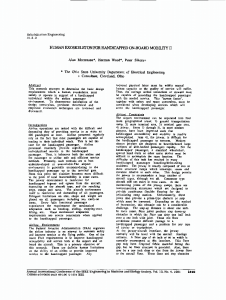Archive for Сентябрь, 2011
Human Exoskeleton For Handicapped On-board Mobility II
- Тип контента: Научная статья
- Номер документа: 964
- Название документа: Human Exoskeleton For Handicapped On-board Mobility II
- Номер (DOI, IBSN, Патент): 10.1109/IEMBS.1991.684771
- Изобретатель/автор: Weed, H., Sikora, P., Mortensen, A.
- Правопреемник/учебное заведение: The Ohio State University
- Дата публикации документа: 2002-08-06
- Страна опубликовавшая документ: США
- Язык документа: Английский
- Наименование изделия: Не заполнено
- Источник: http://ieeexplore.ieee.org/search/freesrchabstract.jsp?tp=&a
- Вложения: Не заполнено
- Аналитик: Не заполнено
Категория: Ищем научные статьи | Нет комментариев »
Improved stability in lower extremity exoskeletons using foot extensions
- Тип контента: Научная статья
- Номер документа: 962
- Название документа: Improved stability in lower extremity exoskeletons using foot extensions
- Номер (DOI, IBSN, Патент): Не заполнено
- Изобретатель/автор: Kumar, R.P., Jungwon Yoon
- Правопреемник/учебное заведение: Res. Center for Aircraft Parts Technol. (ReCAPT), Gyeongsang Nat. Univ., Jinju, South Korea
- Дата публикации документа: 2009-11-13
- Страна опубликовавшая документ: Корея
- Язык документа: Английский
- Наименование изделия: Не заполнено
- Источник: http://ieeexplore.ieee.org/search/freesrchabstract.jsp?tp=&a
- Вложения: Не заполнено
- Аналитик: Не заполнено
 Existing lower extremity exoskeletons lack sufficient foot support area to guarantee safe operation for rehabilitation of patients, and normal posture/gait for users carrying heavy loads on backpack. In order to enhance the stability of lower extremity exoskeletons, an adaptive foot system is presented. It consists of two foot extensions, one extending behind the toe and another on the heel side that extends the support area behind the heel when the foot is flat and retracts when the heel is off the ground. Such a system has an important application in rehabilitation for enhancing stability where safety of patients is critical. We present a detailed description of the adaptive foot system and analyze the stability in sagittal plane.
Existing lower extremity exoskeletons lack sufficient foot support area to guarantee safe operation for rehabilitation of patients, and normal posture/gait for users carrying heavy loads on backpack. In order to enhance the stability of lower extremity exoskeletons, an adaptive foot system is presented. It consists of two foot extensions, one extending behind the toe and another on the heel side that extends the support area behind the heel when the foot is flat and retracts when the heel is off the ground. Such a system has an important application in rehabilitation for enhancing stability where safety of patients is critical. We present a detailed description of the adaptive foot system and analyze the stability in sagittal plane.
Категория: Ищем научные статьи | Нет комментариев »
On active lower limb exoskeletons actuators
- Тип контента: Научная статья
- Номер документа: 960
- Название документа: On active lower limb exoskeletons actuators
- Номер (DOI, IBSN, Патент): 10.1109/ISMA.2008.4648796
- Изобретатель/автор: Cocetta, M., Cinquemani, S., Casolo, F.
- Правопреемник/учебное заведение: Dipt. di Meccanica, Politec. di Milano, Milan
- Дата публикации документа: 2008-10-14
- Страна опубликовавшая документ: Италия
- Язык документа: Английский
- Наименование изделия: Не заполнено
- Источник: http://ieeexplore.ieee.org/search/freesrchabstract.jsp?tp=&a
- Вложения: Не заполнено
- Аналитик: Не заполнено
 Carrying a load increases the metabolic costs of movement: exoskeletons are devices developed primarily to minimize the operatorpsilas energetic contribution for the action. The rise of the exoskeletons research can be set in the second half of the past century. The most important contribution given by these early attempts to develop supporting structures for human use, was to identify and focus the researcherpsilas attention on some key aspects, fundamental for a further implementation of these devices. Among them, the importance of efficient and small supply systems, of precision and control, o simple human interface and of the knowledge of locomotion biomechanics. The aim is a technological approach capable to match the artificial system with the human beings with minimum interactions and maximum synergy. This work deal with the state of art of the projects facing with the development of exoskeletons and active orthoses for the lower limbs. It focuses the actuators problem showing advantages and disadvantages of a variety of technological alternatives. The work is the starting point for a new exoskeleton design.
Carrying a load increases the metabolic costs of movement: exoskeletons are devices developed primarily to minimize the operatorpsilas energetic contribution for the action. The rise of the exoskeletons research can be set in the second half of the past century. The most important contribution given by these early attempts to develop supporting structures for human use, was to identify and focus the researcherpsilas attention on some key aspects, fundamental for a further implementation of these devices. Among them, the importance of efficient and small supply systems, of precision and control, o simple human interface and of the knowledge of locomotion biomechanics. The aim is a technological approach capable to match the artificial system with the human beings with minimum interactions and maximum synergy. This work deal with the state of art of the projects facing with the development of exoskeletons and active orthoses for the lower limbs. It focuses the actuators problem showing advantages and disadvantages of a variety of technological alternatives. The work is the starting point for a new exoskeleton design.
Категория: Ищем научные статьи | Нет комментариев »
Model predictive control-based gait pattern generation for wearable exoskeletons
- Тип контента: Научная статья
- Номер документа: 958
- Название документа: Model predictive control-based gait pattern generation for wearable exoskeletons
- Номер (DOI, IBSN, Патент): 10.1109/ICORR.2011.5975442
- Изобретатель/автор: van der Kooij, H., Van Asseldonk, E.H.F., Letian Wang
- Правопреемник/учебное заведение: Lab. of Biomech. Eng., Univ. of Twente, Enschede, Netherlands
- Дата публикации документа: 2011-08-12
- Страна опубликовавшая документ: Нидерланды (Голландия)
- Язык документа: Английский
- Наименование изделия: Не заполнено
- Источник: http://ieeexplore.ieee.org/search/freesrchabstract.jsp?tp=&a
- Вложения: Не заполнено
- Аналитик: Не заполнено
 This paper introduces a new method for controlling wearable exoskeletons that do not need predefined joint trajectories. Instead, it only needs basic gait descriptors such as step length, swing duration, and walking speed. End point Model Predictive Control (MPC) is used to generate the online joint trajectories based on these gait parameters. Real-time ability and control performance of the method during the swing phase of gait cycle is studied in this paper. Experiments are performed by helping a human subject swing his leg with different patterns in the LOPES gait trainer. Results show that the method is able to assist subjects to make steps with different step length and step duration without predefined joint trajectories and is fast enough for real-time implementation. Future study of the method will focus on controlling the exoskeletons in the entire gait cycle.
This paper introduces a new method for controlling wearable exoskeletons that do not need predefined joint trajectories. Instead, it only needs basic gait descriptors such as step length, swing duration, and walking speed. End point Model Predictive Control (MPC) is used to generate the online joint trajectories based on these gait parameters. Real-time ability and control performance of the method during the swing phase of gait cycle is studied in this paper. Experiments are performed by helping a human subject swing his leg with different patterns in the LOPES gait trainer. Results show that the method is able to assist subjects to make steps with different step length and step duration without predefined joint trajectories and is fast enough for real-time implementation. Future study of the method will focus on controlling the exoskeletons in the entire gait cycle.
Категория: Ищем научные статьи | Нет комментариев »
Estimating arm motion and force using EMG signals: On the control of exoskeletons
- Тип контента: Научная статья
- Номер документа: 956
- Название документа: Estimating arm motion and force using EMG signals: On the control of exoskeletons
- Номер (DOI, IBSN, Патент): 10.1109/IROS.2008.4650949
- Изобретатель/автор: Kyriakopoulos, K.J., Artemiadis, P.K.
- Правопреемник/учебное заведение: Sch. of Mech. Eng., Nat. Tech. Univ. of Athens, Athens
- Дата публикации документа: 2008-10-14
- Страна опубликовавшая документ: Греция
- Язык документа: Английский
- Наименование изделия: Не заполнено
- Источник: http://ieeexplore.ieee.org/search/freesrchabstract.jsp?tp=&a
- Вложения: Не заполнено
- Аналитик: Не заполнено
 There is a great effort during the last decades towards building robotic devices that are worn by humans. These devices, called exoskeletons, are used mainly for support and rehabilitation, as well as for augmentation of human capabilities. Providing a control interface for exoskeletons, that would guarantee comfort and safety, as well as efficiency and robustness, is still an issue. This paper presents a methodology for estimating human arm motion and force exerted, using electromyographic (EMG) signals from muscles of the upper limb. The proposed method is able to estimate motion of the human arm as well as force exerted from the upper limb to the environment, when the motion is constrained. Moreover, the method can distinguish the cases in which the motion is constrained or not (i.e. exertion of force versus free motion) which is of great importance for the control of exoskeletons. Furthermore, the method provides a continuous profile of estimated motion and force, in contrast to other methods used in the literature that can only detect initiation of movement or intention of force. The system is tested in an orthosis-like scenario, during planar movements, through various experiments. The experimental results prove the system efficiency, making the proposed methodology a strong candidate for an EMG-based control scheme applied in robotic exoskeletons.
There is a great effort during the last decades towards building robotic devices that are worn by humans. These devices, called exoskeletons, are used mainly for support and rehabilitation, as well as for augmentation of human capabilities. Providing a control interface for exoskeletons, that would guarantee comfort and safety, as well as efficiency and robustness, is still an issue. This paper presents a methodology for estimating human arm motion and force exerted, using electromyographic (EMG) signals from muscles of the upper limb. The proposed method is able to estimate motion of the human arm as well as force exerted from the upper limb to the environment, when the motion is constrained. Moreover, the method can distinguish the cases in which the motion is constrained or not (i.e. exertion of force versus free motion) which is of great importance for the control of exoskeletons. Furthermore, the method provides a continuous profile of estimated motion and force, in contrast to other methods used in the literature that can only detect initiation of movement or intention of force. The system is tested in an orthosis-like scenario, during planar movements, through various experiments. The experimental results prove the system efficiency, making the proposed methodology a strong candidate for an EMG-based control scheme applied in robotic exoskeletons.
Категория: Ищем научные статьи | Нет комментариев »
Статистика
Категорий: 179
Статей всего: 2,003
По типу:
Видео: 36
Выдержка с форума: 1
Контактные данные: 12
Научная статья: 1388
Не заполнено: 5
Новостная статья: 317
Обзор технологии: 42
Патент: 219
Тех.подробности: 34
Тип: 1
Комментариев: 8,966
Изображений: 3,005
Подробней...
ТОР 10 аналитиков
-
Глаголева Елена - 591
Дмитрий Соловьев - 459
Helix - 218
Ридна Украина))) - 85
Наталья Черкасова - 81
max-orduan - 29
Елена Токай - 15
Роман Михайлов - 9
Мансур Жигануров - 4
Дуванова Татьяна - 3
Календарь
Авторизация
Ошибка в тексте?
Выдели её мышкой!
И нажми Ctrl+Enter

